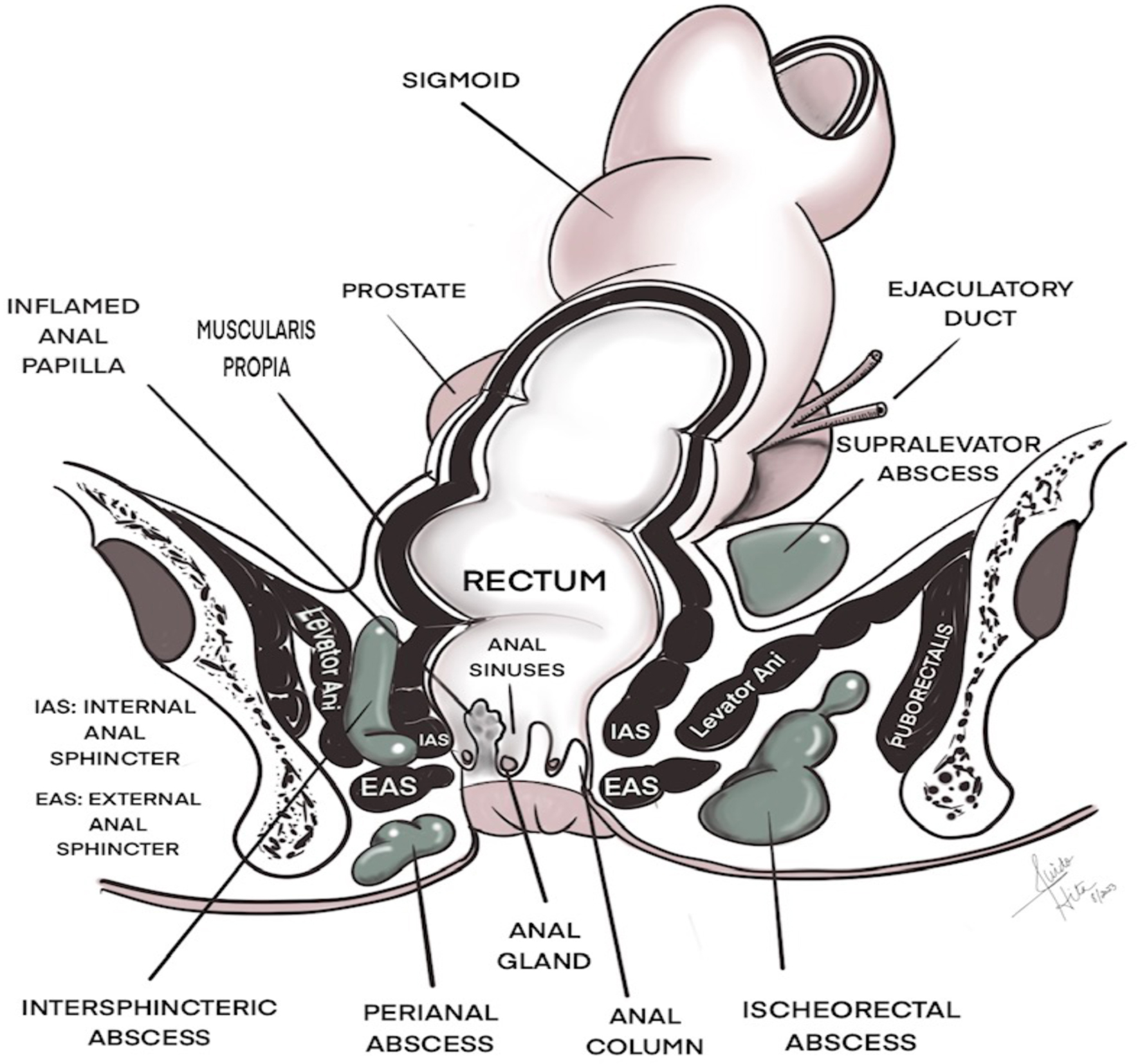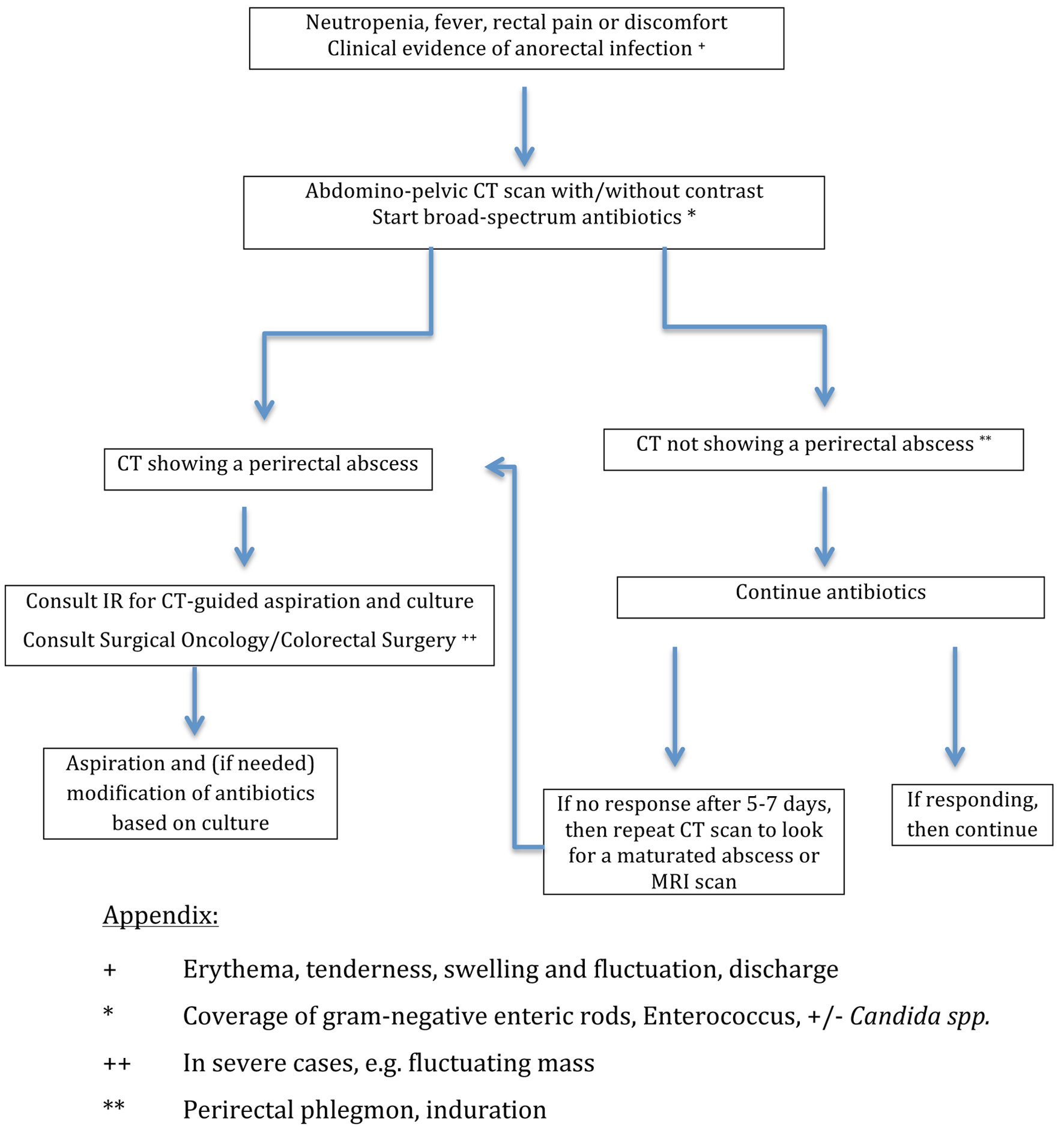
Figure 1. Location of anorectal abscesses.
| Journal of Hematology, ISSN 1927-1212 print, 1927-1220 online, Open Access |
| Article copyright, the authors; Journal compilation copyright, J Hematol and Elmer Press Inc |
| Journal website https://www.thejh.org |
Review
Volume 13, Number 1-2, April 2024, pages 1-11
Anorectal Infections in Neutropenic Leukemia Patients: A Common Clinical Challenge
Figures


Tables
| Sexually transmitted diseases (human papilloma virus, herpes simplex virus, syphilis, chlamydia, gonorrhea, Hemophilus ducreyi) |
| Cytomegalovirus proctitis |
| Histoplasma infection of the anus |
| Anal tuberculosis |
| Inflammatory bowel disease (Crohn’s disease, ulcerative colitis) |
| Pyoderma gangrenosum |
| Complications post radiation therapy for extramedullary focal disease |
| Side effects of medication (e.g., bevacizumab, imiquimod, nicorandil) |
| Malignancies (leukemia deposits in the anorectal area, anal cancer) |
| Autoimmune disorders (systemic lupus erythematosus, Behcet’s disease, sarcoidosis) |
| Dermatological conditions (e.g., psoriasis, Lichen sclerosus) |
| Authors | Study type | Year | Number of patients | Type of cancer | Therapeutic approach | Resolution (n) | Later recurrence (n) |
|---|---|---|---|---|---|---|---|
| Barnes et al [25] | Retrospective | 1984 | 16 | Mixed acute leukemias | Surgical n = 10 | 10 | 0 |
| Spontaneous drainage n = 5 | 5 | 0 | |||||
| Boddie et al [31] | Retrospective | 1986 | 54 (different anorectal pathologies) | Leukemia | Surgical n = 11 | N/A | 4 |
| Conservative management n = 25 | N/A | N/A | |||||
| Glenn et al [46] | Retrospective | 1988 | 44 | Solid and hematological malignancies | Surgical n = 26 | 11 | 4 |
| Conservative management n = 18 | 14 | 9 | |||||
| Carlson et al [47] | Retrospective | 1988 | 20 | Leukemia | Surgical n = 9 | 6 | 3 |
| Conservative management n = 11 | 11 | 0 | |||||
| Grewal et al [48] | Retrospective | 1994 | 81 (different anorectal pathologies | Leukemia | Surgical n = 29 | N/A | N/A |
| Conservative management n = 54 | N/A | N/A | |||||
| North et al [16] | Retrospective | 1996 | 25 | Acute and chronic leukemias | Surgical n = 13 | 13 | 0 |
| Conservative management n = 12 | 7 | 5 | |||||
| Buyukasik et al [21] | Retrospective | 1998 | 20 | Acute and chronic leukemias | Surgical n = 10 | 9 | 1 |
| Conservative management n = 10 | 3 | 7 | |||||
| Lehrnbecher et al [22] | Retrospective | 2002 | 64 | Solid and hematological malignancies | Surgical n = 25 | 18 | 7 |
| Conservative management n = 39 | N/A | N/A | |||||
| Badgewell et al [11] | Retrospective | 2009 | 100 | Solid and hematological malignancies | Surgical n = 58 | N/A | N/A |
| Conservative management n = 42 | N/A | N/A | |||||
| Morcos et al [10] | Retrospective | 2013 | 13 | Solid and hematological malignancies | Surgical n = 13 | 13 | N/A |
| Loureiro et al [24] | Retrospective | 2018 | 27 | Mixed hematological malignancies | Surgical n = 15 | 14 | 1 |
| Conservative management n = 12 | 9 | 2 |
| CT: computed tomography; G-CSF: granulocyte colony-stimulating factor; MDR: multidrug resistant; WBC: white blood cell. |
| Risk factors |
| Composition of the microbiome |
| Impact of comorbidities (e.g., diabetes mellitus) |
| Influence of prior gastrointestinal infections |
| Type and sequence of chemotherapy |
| Modulating effect of antibacterial and antifungal prophylaxis to the presentation, severity and pathogens associated with anorectal infections |
| Management |
| Is there a predictive value of rectal swabs? |
| Optimal empiric choice and duration of anti-infective therapy |
| Time to transition from intravenous to oral antibiotics |
| Best strategies for source control (incision and drainage vs. percutaneous drainage) and ideal timing |
| Indication and timing for granulocyte transfusion |
| Pain management, effective use of non-narcotics |
| Prevention |
| How to modify anti-infective prophylaxis to reduce the recurrence rate of perianal infections? |
| Is there a role of surgical management of anal fissures, thrombosed hemorrhoids prior to next chemotherapy? |
| Timing of restarting subsequent chemotherapy? Is a repeat CT scan of the abdomen/pelvis indicated to assess this? |
| Is there a need to modify chemotherapy in a patient with recent severe anorectal infection? |
| Is there are role of G-CSF as prophylaxis? |
| Is there a role for WBC transfusions in selected patients (severe episodes, isolation of an MDR pathogen) to prevent relapse? |